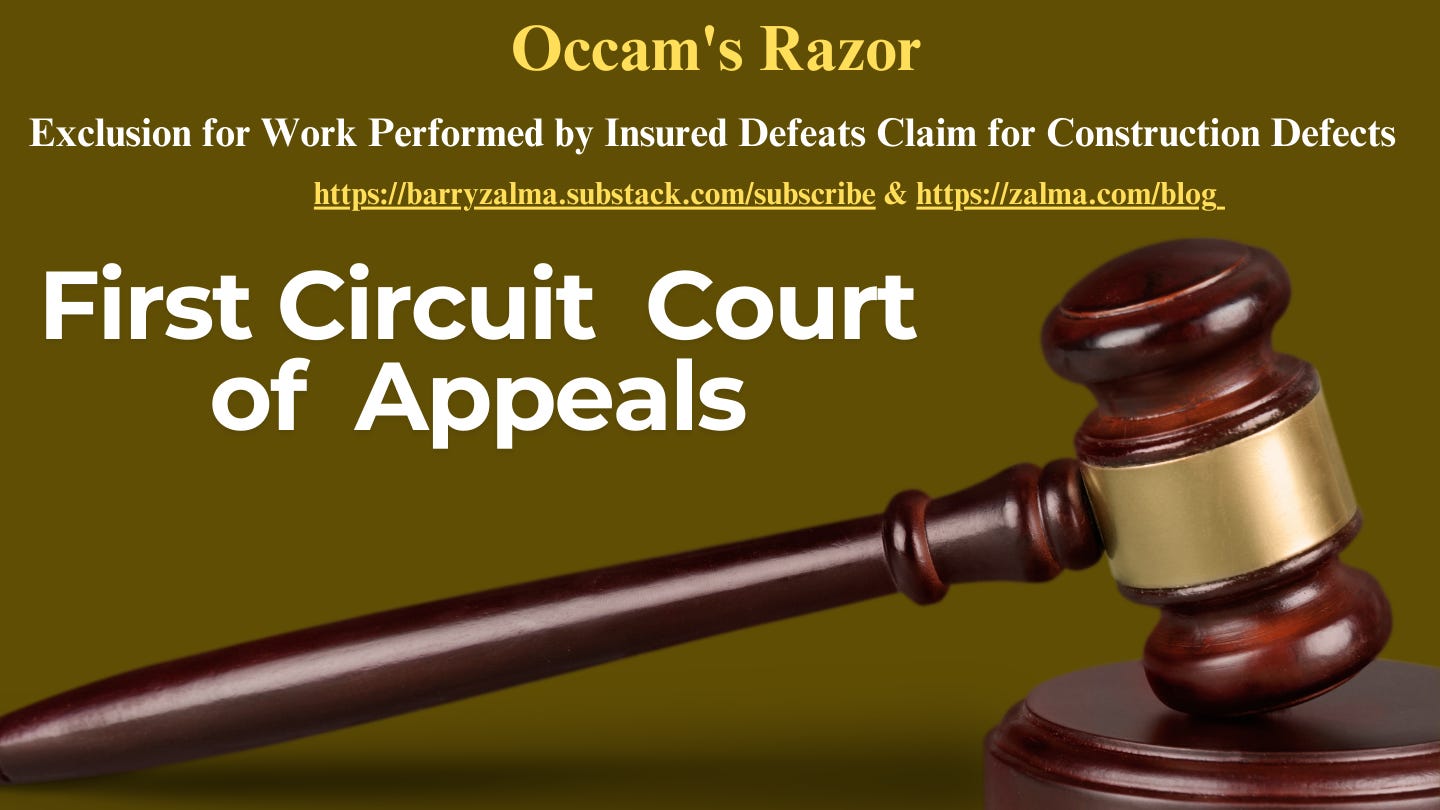Post 4935
Read the full article at https://lnkd.in/gT_NsMHv, see the full video at https://lnkd.in/gqkPHYbp and at https://lnkd.in/gEEXkUe3, and at https://zalma.com/blog plus more than 4900 posts.
The question presented to the U.S. First Circuit Court of Appeals was whether a contractor’s CGL insurance policy covers general damage to a non-defective part of the contractor’s project resulting from a subcontractor’s defective work on a different part of that project.
APPLICATION OF OCCAM’S RAZOR
The analysis technique that proposes that the simplest of competing theories be preferred to the more complex.
FACTUAL BACKGROUND
Applying Massachusetts law, the district court concluded that Admiral had no duty to defend Tocci in Admiral Insurance Company, Starr Indemnity & Liability Company, Great American Assurance Company v. Tocci Building Corporation, Tocci Residential LLC, John L. Tocci, Sr., No. 22-1462, United States Court of Appeals, First Circuit (November 8, 2024) and Tocci appealed.
From 2013 to 2016, Tocci was the construction manager for an apartment project owned by Toll JM EB Residential Urban Renewal LLC (“Toll”). There were several work quality issues and delays on the project, and Toll eventually terminated Tocci in March 2016 for alleged mismanagement of the project.
Toll sued with allegations regarding instances of defective work leading to property damage. The allegations included defective work by Tocci’s subcontractors resulting in various instances of property damage to non-defective work on the project, including (1) damage to sheetrock resulting from faulty roof work; (2) mold formation resulting from inadequate sheathing and water getting into the building; and (3) damage to a concrete slab, wood framing, and underground pipes resulting from soil settlement due to improper backfill and soil compaction.
DUTY TO DEFEND
Tocci sought defense and indemnity coverage under the Admiral insurance policies. Admiral denied coverage.
The district court granted Admiral’s motion on duty to defend because the damage alleged in Toll’s complaint did not qualify as “property damage” as defined in the policy because the allegations consisted entirely of damage at Tocci’s own project.
ANALYSIS
The First Circuit considered three steps to the coverage analysis: (1) Do the damages alleged in the action fall within the scope of coverage?; (2) if so, do the exclusions to coverage apply?; and (3) if so, do any exceptions to the exclusions apply?
The First Circuit noted that there is a sharp split of authority on whether damage to non-defective work resulting from a subcontractor’s defective work constitutes “property damage” or is caused by an “occurrence.” The First Circuit decided to avoid the issues of what constitutes “property damage” by focusing on the exclusions which were sufficient to resolve the complete dispute.
THE HOLDING
There are two “Damage to Property” exclusions that provide that there is no coverage for “property damage” to: that particular part of real property on which you or any contractors or subcontractors working directly or indirectly on your behalf are performing operations, if the ‘property damage’ arises out of those operations; or that particular part of any property that must be restored, repaired or replaced because “your work” was incorrectly performed on it.
The First Circuit, applying Occam’s Razor, focused its analysis on the exclusion it concluded covers the allegations in the Toll complaint. Since the complaint alleges damage resulting from Tocci’s “incorrectly performed” work on the entire project “[t]hat particular part of any property that must be restored, repaired or replaced because ‘[Tocci’s] work’ was incorrectly performed on it” refers to the entirety of the project where Tocci was the general contractor charged with supervising and managing the project as a whole.
Therefore, the First Circuit concluded that Admiral met its burden of establishing that the Toll action only alleges damage falling within the exclusion and that there was no exception to that exclusion that applied.
ZALMA OPINION
This is a case of a court applying Occam’s Razor, by picking an easy and obvious solution – the application of an exclusion – and avoiding the problem of different court rulings on coverage about “property damage” and “occurence.” Since the exclusion clearly applied there was no duty to defend.
(c) 2024 Barry Zalma & ClaimSchool, Inc.
Please tell your friends and colleagues about this blog and the videos and let them subscribe to the blog and the videos.
Subscribe to my substack at https://barryzalma.substack.com/subscribe
Go to X @bzalma; Go to Newsbreak.com https://www.newsbreak.com/@c/1653419?s=01; Go to Barry Zalma videos at Rumble.com at https://rumble.com/account/content?type=all; Go to Barry Zalma on YouTube- https://www.youtube.com/channel/UCysiZklEtxZsSF9DfC0Expg
Go to the Insurance Claims Library – https://lnkd.in/gwEYk
Subscribe to my substack at https://lnkd.in/gmmzUVBy



















Share this post